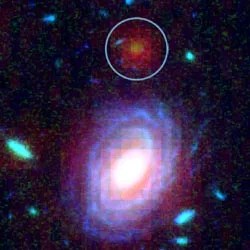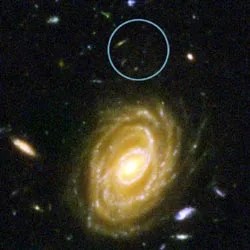Two of NASA's Great Observatories, the Spitzer and Hubble Space Telescopes, have teamed up to "weigh" the stars in several distant galaxies. One of these galaxies, among the most distant ever seen, appears to be unusually massive and mature for its place in the young universe.
Image right:
A combined visible and infrared view of galaxy HUDF-JD2. In the browse image, Hubble's visible light image is in the upper right, Hubble's near infrared view is in the lower left, Spitzer's infrared camera is in the lower right and the combined view of all three images in the upper left.
This came as a surprise to astronomers. The earliest galaxies in the universe are commonly thought to have been much smaller associations of stars that gradually merged to build large galaxies like our Milky Way.
"This galaxy, named HUDF-JD2, appears to have 'bulked up' amazingly quickly, within the first few hundred million years after the big bang. It made about eight times more mass in stars than are found in our own Milky Way today, and then, just as suddenly, it stopped forming new stars," said Dr. Bahram Mobasher of the Space Telescope Science Institute, Baltimore, and the European Space Agency, Paris.
Image left:
A view of galaxy HUDF-JD2 in visible light.
The galaxy was pinpointed among approximately 10,000 others in a small patch of sky called the Hubble Ultra Deep Field. The galaxy is believed to be about as far away as the most distant known galaxies. It represents an era when the universe was only 800 million years old. That is about five percent of the universe's age of 14 billion years.
Scientists studying the Ultra Deep Field found this galaxy in Hubble's infrared images. They expected it to be young and small, like other known galaxies at similar distances. Instead, they found evidence the galaxy is remarkably mature and much more massive. Its stars appear to have been in place for a long time.
Hubble's optical-light Ultra Deep Field image is the deepest image ever taken, yet this galaxy was not evident. This indicates much of the galaxy's optical light has been absorbed by traveling billions of light-years through intervening hydrogen gas. The galaxy was detected using Hubble's near-infrared camera and multi-object spectrometer. It was also detected by an infrared camera on the Very Large Telescope at the European Southern Observatory. At those longer infrared wavelengths, it is very faint and red.
The big surprise is how much brighter the galaxy is in longer-wavelength infrared images from the Spitzer Space Telescope. Spitzer is sensitive to the light from older, redder stars, which should make up most of the mass in a galaxy. The infrared brightness of the galaxy suggests it is massive. "This would be quite a big galaxy even today," said Dr. Mark Dickinson of the National Optical Astronomy Observatory, Tucson, Ariz. "At a time when the universe was only 800 million years old, it's positively gigantic."
Spitzer observations were also independently reported by Dr. Laurence Eyles from the University of Exeter in the United Kingdom and Dr. Haojing Yan of the Spitzer Science Center, Pasadena, Calif. They also revealed evidence for mature stars in more ordinary, less massive galaxies at similar distances, when the universe was less than one billion years old.
The new observations reported by Mobasher extend this notion of surprisingly mature "baby galaxies" to an object which is perhaps 10 times more massive, and which seemed to form its stars even earlier in the history of the universe.
Mobasher's team estimated the distance to this galaxy by combining information provided by the Hubble, Spitzer, and Very Large Telescope observations. The relative brightness of the galaxy at different wavelengths is influenced by the expanding universe and allows astronomers to estimate its distance. They can also get an idea of the make-up of the galaxy in terms of the mass and age of its stars.
While astronomers generally believe most galaxies were built piecewise by mergers of smaller galaxies, the discovery of this object suggests at least a few galaxies formed quickly long ago. For such a large galaxy, this would have been a tremendously explosive event of star birth.
JPL manages the Spitzer Space Telescope mission for NASA. Science operations are conducted at the Spitzer Science Center at the California Institute of Technology in Pasadena.The Hubble Space Telescope is a project of international cooperation between NASA and the European Space Agency. The Very Large Telescope is a project of the European Southern Observatory at the Paranal Observatory in Atacama, Chile.
For more information and additional images visit:
http://www.spitzer.caltech.edu/Media
and
http://hubblesite.org/news/2005/28
Gay Yee Hill (818) 354-0344
Jet Propulsion Laboratory, Pasadena, Calif.
Ray Villard (410) 338-4514
Space Telescope Science Institute, Baltimore, Md.
Erica Hupp/George Deutsch (202) 358-1237/1324
NASA Headquarters, Washington
2005-156



































